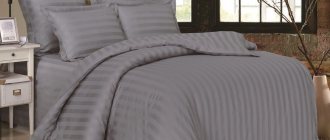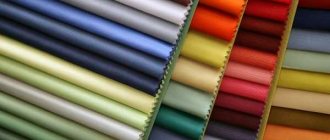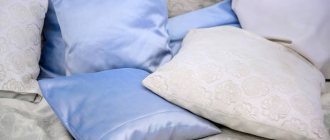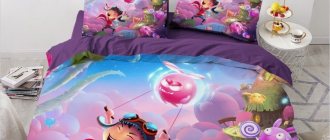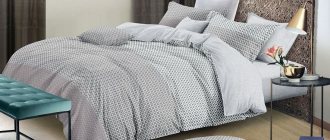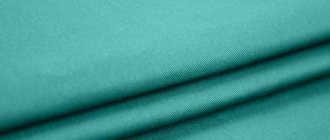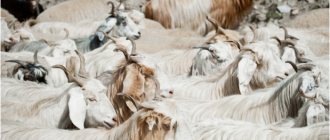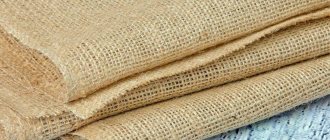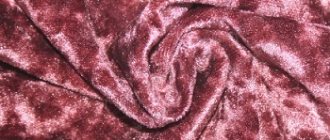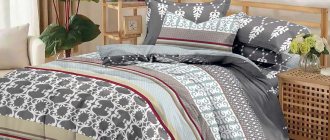Description
Mako-satin is a cotton fabric with a satin weave, but it is denser, unlike sateen. The prefix “Mako” refers to cotton grown in Egypt. The raw materials are considered to be of high quality, although in the end they cost a lot of money. Cotton produced in warm regions is in great demand among factories around the planet, as the average fiber length reaches 35-45 mm.
A little history
According to the legend of the Egyptians themselves, the plant owes its name to the owner of the ancient garden Mako Bey ate Orfali, where the flower was accidentally discovered by one of the French textile engineers, Louis Jumel. Subsequently, in his native France, the man found a way to use the fibers of the find to make fabric. Subsequently, factories from different parts of the planet took over the idea, and the French began to call the material “Jumelle” in honor of the person who managed to create a high-quality product.
Satin or mako-satin?
Just by the name of the fabric, it becomes clear that it has common properties with satin. The same natural composition, identical weave type, strength and durability are characteristic of both materials. But, having assessed the price range of bed linen sets, one can judge the best quality of mako-satin fabric. What kind of fabric is this?
Photos and descriptions of mako-satin confirm that the material has a characteristic light matte sheen. This is one of the varieties of regular satin with a higher density (220 threads per 1 cm2), but at the same time quite light. Its weight is 125 g/m2. It is smooth and soft like satin, but has increased strength, which is explained by a more complex production method. Mako-satin is widely used for the production of luxury bed linen from famous brands. Due to its similarity to silk, the material is also used in the manufacture of various women's and men's clothing, for example, blouses, dresses, shirts, skirts, scarves, and ties.
Compound
If you are wondering what mako-satin is and what the fabric is made of, then you can safely answer - it is 100% cotton. Thanks to a special dyeing technology, the dye penetrates deeply into the threads. This ensures a durable and rich color of the fabric, and subsequently, owners of products made from this material do not have to worry that the fabric will change color during use, because it can withstand hundreds of washing cycles.
Fabric properties - personal experience
Mako satin - reviews - this is a separate collection of speeches of gratitude towards the discoverer of this material. Buyers of products talk about 6 main properties of fabric:
- Environmental friendliness of the material.
- Soft material, but non-slip.
- The feel and appearance of the fabric is similar to silk.
Silk
- Suitable for people with hypersensitive skin.
- Dries quickly after washing.
- Does not accumulate static electricity.
Properties
The resulting material is light and pleasant to the touch, and the good fiber density per square centimeter (up to 230 hairs after twisting) is considered high among the rest. No additional components are added to the thread, so there is no need to worry about allergic reactions on the skin. During the manufacturing process in specialized workshops, the threads undergo mercerization. The use of technology gives the raw material a light, unnoticeable shine, which makes the material stand out among other cotton products.
Mako-satin has the following properties:
- Not electrified;
- does not cause allergic reactions;
- has a glossy tint;
- good density and strength, which makes the material more wear-resistant;
- hygroscopic (permeable to air).
Mako-satin (mako cotton) - what kind of fabric is it, description
To understand what this material is, it is worth considering it from different angles:
Production
The manufacturing process of the fabric is not much different from that of ordinary cotton. First, the threads are combed, cleaned, and washed well. After this, mercerization is carried out - treatment with caustic soda. After this, the material becomes silky, the threads become thinner, softer, and acquire elasticity. The procedure also prevents fading in the future. Next, the fabric is bleached and dyed. This process is non-standard, each thread is treated with paint. This approach ensures the durability of the paint.
Nothing other than cotton is ever added to the composition. That is, it is completely natural and does not cause allergic reactions.
Texture and density: what it looks like
Mako-satin is a very light and silky material, and, unlike supplex material, it has a density of 180-230 threads per square centimeter, which is one of the highest values. The fabric is smooth to the touch and glides over the body. Mercerization gives a light, barely noticeable shine and shine, giving it a special appearance.
Properties and quality of the material
Thin, long, but strong fibers are obtained from only one type of cotton. It is grown in Egypt, accounting for only about 5% of the world's total production. Places of growth - areas of Peru, Egypt, Sudan and Pakistan. This variety does not take root anywhere else, which is why it is so rare. Also, the high cost is due to the fact that this species takes almost twice as long to ripen than conventional varieties. At the same time, the final amount of usable raw materials is the same amount less. Find out about the types of terry fabrics at this link.
The main suppliers are known all over the world. Their products are distributed everywhere, and they understand this, so when growing they do not use any special fertilizers other than natural ones. This makes the fabric as safe as possible for constant use.
Application: what is sewn from fabric
The material is universal, it is used in the production of many products, but the main ones can be divided into 3 groups:
Bed sheets
If you are wondering what fabric to choose for bed linen, then mako-satin is the most common use of this material. Thanks to its complete naturalness, it will not harm the body in any way. Lightness and silkiness provide a pleasant sensation, which affects the quality of sleep. In terms of tactile sensations, it can be compared to silk, but noticeably softer. Mako satin linen is considered elite. The average price of one 1.5-bedroom set is 2500-3000 rubles. Read about reviews and other data about polysatin bedding here.
Bedspreads
Bedspreads for beds, sofas, armchairs and the like have properties similar to bed linen. They can decorate any furniture, and sitting or lying on them will be much more pleasant than on bare furniture.
Accessories
This includes belts, headscarves, light scarves, and shawls. Usually these are items for a summer-spring look, because mako satin does not give off heat well due to its smoothness. But in the hot summer, light and airy things will be just right. This material will tell you which insulation to choose for winter clothes.
Application
Mako satin has a wide area to use, although it is an expensive fabric. They often make wardrobe and interior items.
Bed dress
Widely used for sewing bed linen (3D and 5D), creating the effect of realistic drawing. Most designers in the textile industry choose this material and certainly include it in the premium line of manufactured products. Every connoisseur of natural ingredients would want to have a finished product made from high-quality material in their collection.
Bedspreads
Mako satin matte color with a slight gloss is used as bedspreads. A person does not experience discomfort from being on textile products, but, on the contrary, enjoys it.
Finishes and accessories
Often, clothing designers use it for scarves, scarves, stoles, and even make belts. When worn, ready-made accessories are soft and pleasant to the body; they warm you in winter and, on the contrary, cool you in summer.
Unfavorable reviews
You should not think that if mako satin is considered an elite and expensive material, then it is loved by everyone. These are the negative reviews left about mako satin bed linen.
Karina Velikanova, 27 years old:
“One day I decided to try ordering online. I saw makosatin bed linen there. She also suggested it to her mother-in-law. She, of course, doubted that such expensive bed linen was worth ordering online. But I also decided and placed an order. We waited a long time - about two months. But when they picked up their bed linen, they were very happy. We really liked the colors and richness of colors. And the fabric was soft and pleasant to the touch. The guests had just arrived. We offered to try our bedding. They spent the night with us for 4 days. When the guests left, I threw the bed linen in the wash. She pulled it out and was stunned. After washing, the bed linen was very faded.”
Mako satin bed linen
Yana Novikova, 21 years old:
“The guy gave me beautiful bed linen made of an unknown fabric called makosatin for his birthday. I knew nothing about this material before. I am very picky when choosing fabrics for things, so I immediately went online with the request “mako satin bed linen reviews.” I read it on the forums. Everyone notes that the fabric is good and pleasant to the touch. I calmed down, laid down the bed linen and went to bed. I couldn't sleep for 3 hours! The sheet seemed terribly sticky to me and did not provide any warmth at all. And when I saw the cost of the product... Such bed linen is not worth the money that my boyfriend paid. Cotton sets are 10 times nicer and cost less.”
Macosatin bed linen
Veronika Mironova, 54 years old:
“My husband unexpectedly decided to make a gift - he gave me a mako-satin robe. A very expensive thing, we usually don’t afford it. Of course, I appreciated the quality. It was pleasant, soft and velvety, the color itself was rich and very deep. I was completely delighted then, but the happiness lasted until the first wash... I followed all the care rules, but the fabric shrunk a little. For such a price this definitely shouldn't have happened. We decided that the product was not worth the money, and my husband and I would no longer make a choice in favor of mako-satin.”
You might be interested in this Real reviews about polysatin and bedding made from it
Macosatin robe
The difference between mako-satin and satin
What is the difference between satin fabric and similar mako-satin, except for the name. Both materials have only the same weaving method. The very density of the fabric obtained artificially is up to 130-120 threads per 1 m² centimeter. But the density of Mako-satin threads varies from 200-220. Naturally, different quadratures affect the wear resistance of the finished product. A product made from mako-satin will last many times longer, and at the same time the appearance will be well preserved.
The similarity of the two names is in smoothness, lightness and pleasant sensations during touch. Sleeping on the products is a pleasure, although the difference in pricing is noticeable.
The best manufacturers
It is worth buying such things from trusted sellers. Small single outlets are never associated with such expensive products, because they are unlikely to sell them well. But they can pass off something of lower quality as the original, but it’s difficult to confuse it. You just need to know the main manufacturers, of which there are not many:
Linetex
The Linetex company is also located in Russia. There is little information about the company itself, but its products can be found in luxury stores throughout the country. This article will tell you about bed linen from the French Estia collection.
Balimena
This is the Russian branch of the British company FRANCIS DINSMORE LTD. It has been on the market for more than 10 years and all this time it has been producing various types of premium bed linen made from mako satin. Also in its assortment there are other types: satin, calico, percale. The company has agents directly in the producing countries of the canvas, which allows you to be absolutely sure of the authenticity. Find out the difference between poplin and calico here.
Care
By observing the requirements for the use of textiles, you can ensure a good service life for your purchase:
- It is not recommended to wash fabric at temperatures above 40 degrees to protect it from destruction of the fibers;
- Before washing, turn the item inside out. This will help avoid the appearance of unpleasant threads that aggravate the overall purchase experience;
- Do not use products that contain bleach. The components destroy the structure of the fabric and wash away the beautiful color of the color. The difference from the original appearance will be significant;
- Please note that washing with synthetic items is not recommended. If you do this incorrectly, the product will eventually deteriorate and will be unsuitable for further use;
- If large stains have formed on the laundry, it is better to get rid of them manually. In most cases, the washing machine is powerless.
